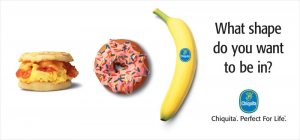Obesity is an important health issue today because it leads to increased risks of heart disease, hypertension and type 2 diabetes. People are very aware of the obesity epidemic in the U.S. but there does not seem to be a significant decrease in the issue, due to the availability and convenience of unhealthy foods. Food impacts these problems because unhealthy processed foods are easily available and cheaper.
In our opinion, nutrient density (macro and micronutrients), appropriate portions (avoid caloric super surpluses), and balance/moderation are key to a healthy diet. “Good” food is nutrient dense and provides all of the necessary nutrients. Additionally, “good” food is in an appropriate amount. Any food in too much excess can be considered “bad.” Bad foods can also be classified by too much processing, additives and synthesized production, such as added hormones or trans fats.
Most of our advertisements were addressing obesity or trying to draw attention to the healthier aspect of the meal, rather than the processed or synthesized components. For example, Abby found a Cheerio’s advertisement that draws attention to the “low cholesterol,” to distract from the added sugars. One of Carime’s ads addressed dairy and encouraged people to eat more plant-based, which could be a result of targeting or obesity or as promoting veganism. Gemi found advertisements that showed how different countries portray healthy foods in their advertisements. For example, in America advertisements use family and relationships as an incentive to eat healthy and reduce obesity. In China, advertisements would show the diseases and deaths that result from obesity and show products that are necessary to avoid obesity and death. In Japan, they advertise products by showing how they are better than “junk” foods that may increase obesity. They imply that their products make it easy to avoid obesity.
